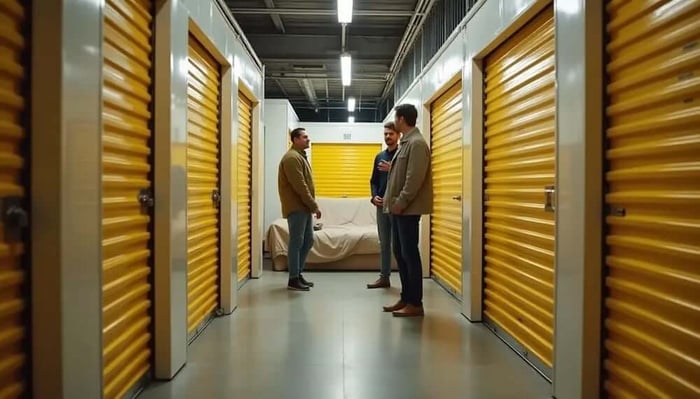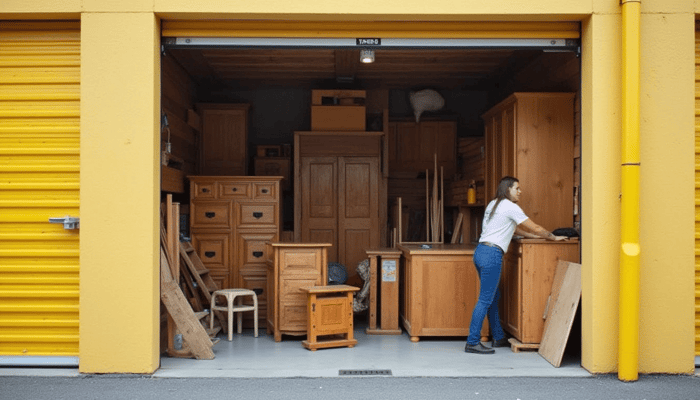Table of Contents
If you’re downsizing, in between homes, or even just decluttering, storing furniture in a self-storage unit is just downright practical. To ensure your furniture stays in excellent condition, bulky items, such as couches and upholstered furniture, need to be thoughtfully prepared. (Sorry, no tossing your items into a unit!)
If you’re curious how to store furniture in a storage unit the right way, such as how to store a couch in storage without damage, you’re in the right place! Our guide will walk you through the process of prepping, protecting, and placing your furniture for self-storage. You can rest assured that you’ll be retrieving it in good condition.
Why should I protect my furniture in storage?
For starters, furniture can be a significant investment. And other furniture may have sentimental value. You don’t want to waste your money or your feelings if your furniture gets damaged. Improper storage can lead to mold, warping, mildew, tears, or even pest infections.
Knowing how to protect your furniture in storage is just as important as choosing the proper storage unit size. That’s why solid preparation of your couches, loveseats, and recliners is key.
Step 1: Clean Your Furniture
Before you place your furniture into a storage unit, clean it thoroughly.
Couches & Upholstery: Vacuum all sides and under the cushions. For stains, use a fabric-safe cleaner to spot treat. Make sure the couch air dries completely. You want to avoid trapping moisture.
Wood Furniture: Dust and clean your furniture using a gentle wood cleaner (Our team loves this almond-scented cleaner by Method) and a microfiber cloth. Apply furniture wax to add a protective layer. This will help maintain moisture balance.
Leather Furniture: Clean your leather furniture and then use a leather conditioner to help prevent cracking or drying out.
Another perk of cleaning your furniture? You’ll help prevent any unwanted smells and deter pests in your storage unit. While we recommend climate-controlled storage for furniture, if you’re storing anything in an outdoor drive-up unit, you want to do what you can to eliminate odor and pests.
Step 2: Disassemble if Possible
Taking apart your furniture will make it easier to transport and maneuver. Plus, it will help you maximize space in your self-storage unit.
Remove the legs from couches, tables, and chairs
Disassemble your bed frame. Make sure to remove the headboard, footboard, side rails, slats, and support beams.
Take off cushions. Store them in breathable bags or wrapped in moving blankets. If they take up too much room, use vacuum-sealed bags
Label all furniture hardware and parts in sealed bags. Tape the bags to the main furniture piece or store them in furniture drawers. You’ll have everything handy for reassembly
This step is crucial when you’re deciding how to store furniture in a storage unit that has limited square footage (such as a 5x5 or 5x10 storage unit!).

Step 3: Cover & Protect Your Furniture
When storing your furniture, you need to do more than toss a sheet over a sofa! To truly protect your furniture, consider:
Using Furniture Covers or Blankets: Use breathable covers! Opt for specialty furniture covers, cotton sheets, or even moving blankets
Wrap Fragile Pieces: For furniture with glass, mirrors, or delicate surfaces, use bubble wrap or foam padding on them. To keep the padding in place, secure it with a piece of packing tape or mover’s stretch wrap. This will help prevent breakage and dents
Elevate Furniture Off the Floor: Keep your items off the ground in case there’s moisture on the ground. Use pallets or furniture risers to give your furniture a lift
If possible, we do not recommend using plastic covers or plastic sheeting for long-term furniture because of moisture buildup, which can lead to mold growth, warping, or cracking. If you are using plastic covers during a move, make sure to remove them once in storage - or leave them partially open to allow air circulation.
Step 4: Choose the Right Storage Unit
When storing furniture, consider the type and size of the storage unit. At Storage Star, we always recommend renting climate-controlled storage. It can make a massive difference if you’re wondering how to store a sofa in a storage unit for several months or an extended period.
Check out our climate-controlled storage guide to learn what other items should be kept in a temperature-controlled unit.
Some size considerations include:
5x10: Good for furniture such as a twin mattress, small dresser, coffee tables, and a small bookshelf
10x10: Fits items such as a queen or full-sized mattress, small couch and loveseat, dining table with 2-4 chairs, and a desk and office chair
10x15: Can hold sofas, a sectional sofa, queen and king bedroom sets, and office furniture
10x20: Can accommodate a 3-5 piece living room set, a dining room set with 4-6 chairs, complete bedroom sets, and a sectional sofa
Make sure to check with your local Storage Star storage facility for available unit sizes and their recommendations.
Step 5: Store Strategically
After you’ve cleaned, disassembled, and protected everything, it’s time to store furniture in a storage unit! Be strategic in how you arrange your furniture to prevent damage and make retrieval easy.
Here are a few of our top storage tips on effective furniture storage:
Store your couch vertically (on the armrest) to save space
Place large, heavy items on the bottom
Create an open aisle for easy access to each item
Avoid pressing items directly against the walls of the unit to allow airflow and reduce mildew risk
Avoid storing food or scented items that may attract pests or cause your upholstery to pick up an odor
Use moisture absorbers or desiccant packs inside the unit to reduce humidity
When contemplating how to store furniture in a storage unit, especially when dealing with multiple large pieces, planning ahead is crucial for space optimization and optimal protection.
Make the Most of Self-Storage for Storing Furniture
When you’re storing furniture, it requires a little bit of effort - even if you initially thought it wouldn’t! But the proper preparation will help your items remain in pristine condition. Choosing the right unit and arranging your items carefully will play a significant role in long-term preparation.
Ready to reclaim extra space in your home? Storage Star is here to help! Our clean, secure, and climate-controlled storage units will help you store your furniture with confidence.
Our flexible storage solutions and month-to-month leases can fit your specific storage space needs. Find a location near you and rent your unit online today! You’ll have peace of mind knowing that your furniture is in the good hands of Storage Star.
FAQs
What is the best way to store furniture in a storage unit?
Clean it thoroughly, disassemble the large pieces, cover it with a breathable material, and elevate the item off the floor.
Should I use plastic covers when storing furniture?
Simply put, no. You should avoid using plastic covers for long-term storage. They can trap moisture and cause mold or mildrew.
Is climate control necessary when storing furniture?
While it isn't always necessary, we do recommend it, especially for storing wood, leather, antique, or upholstered furniture. Climate-controlled storage can help prevent warping, cracking, and mold.
How can I prevent mold and mildew when storing furniture?
Make sure your furniture is completely dry before you put it into storage. Use moisture absorbers or desiccant packs. Make sure there's airflow around the furniture. Do not press the furniture directly against the storage unit walls.
Can I store leather furniture in a storage unit?
Yes, you can. You should store leather furniture in a climate-controlled storage unit. Clean and condition it properly before storage.
What size storage unit do I need for furniture?
We recommend selecting at least a 10x10 storage unit. This is one of the most popular storage unit sizes for storing living room furniture and bedroom sets. If you're storing the contents of a 3-4 bedroom house, select a 10x15, 10x20, or larger.






